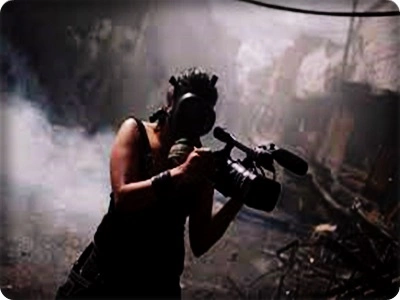Covering conflicts and wars is an essential yet dangerous task for journalists. In the ever-changing landscape of global politics, it is crucial to ensure the safety and well-being of those who risk their lives to report on events unfolding in conflict zones. This blog post aims to explore the various measures that can be taken to create a sense of security for journalists covering the world in the arena of war between countries. From comprehensive training programs to technological advancements, we will delve into strategies that can help protect journalists and enable them to carry out their critical work.
Section 1: Introduction
In today’s interconnected world, journalism plays a vital role in keeping citizens informed about events happening both locally and globally. However, reporting from conflict zones presents unique challenges. Journalists face physical dangers, psychological distress, and various logistical difficulties while navigating through war-torn regions. It falls upon governments, media organizations, NGOs, and individuals alike to prioritize journalist safety and create an environment where they can operate with a sense of security.
Section 2: Training Programs for Journalists
Comprehensive training programs are pivotal in equipping journalists with the necessary skills to navigate through high-risk environments safely. These programs should cover first aid techniques, risk assessment strategies, conflict reporting ethics, digital security practices, and situational awareness training. Organizations such as Reporters Without Borders (RSF) and International News Safety Institute (INSI) offer specialized courses aimed at enhancing journalist safety.
Moreover, collaboration with experienced war correspondents or embedding journalists within military units can provide practical knowledge on surviving in conflict areas. Training should also focus on trauma management since journalists often witness horrific events that can have long-lasting effects on their mental health.
Section 3: Supportive Infrastructure
Creating a supportive infrastructure is crucial for ensuring journalist safety in conflict zones. Establishing secure communication channels, such as encrypted messaging apps and satellite phones, can help journalists stay connected with their colleagues and transmit information securely. Media organizations should provide journalists with proper protective gear, including ballistic vests, helmets, and gas masks.
Additionally, governments and international bodies must facilitate the issuance of press credentials and ensure that they are respected by all parties involved in the conflict. This recognition as a journalist can serve as a shield against potential harm.
Section 4: Local Guides and Fixers
Local guides and fixers play an integral role in ensuring the safety of journalists operating in war zones. These individuals possess valuable knowledge of the local area, language skills, cultural understanding, and contacts within communities. Collaborating with trusted local partners improves journalists’ ability to navigate dangerous terrain while minimizing risks associated with unfamiliarity.
Media organizations should invest in building relationships with reputable fixers who have a proven track record of keeping journalists safe. Providing training on ethical considerations for engaging fixers is equally important to avoid unintentional harm or compromising security.
Section 5: Digital Security Measures
In today’s digital age, protecting sensitive information is paramount. Journalists reporting from conflict zones are at risk of surveillance, hacking attempts, or data theft by state actors or non-state entities. Implementing robust digital security measures is crucial for safeguarding information integrity and protecting both journalists and their sources.
Encrypted email services, virtual private networks (VPNs), secure file storage solutions, two-factor authentication (2FA), and secure messaging apps are some essential tools that journalists should utilize to protect their communication channels. Regularly updating software patches and adhering to best practices for online security can significantly reduce vulnerability to cyber threats.
Section 6: Collaboration Between Media Organizations
Collaboration between media organizations is vital for sharing resources, intelligence on risks faced by journalists, and best practices for operating in conflict zones. Establishing networks where organizations can exchange information about potential dangers and provide mutual support can enhance journalist safety.
Coordinated efforts can also include joint assignments where journalists from different organizations work together, share expertise, and ensure better security measures are in place. This collaboration fosters a sense of community among journalists facing similar challenges and provides a platform for collective advocacy for their safety.
Section 7: Advocacy for Journalist Safety
Ensuring the safety of journalists requires continuous advocacy efforts on multiple fronts. Governments must be held accountable for protecting journalists’ rights, investigating attacks against them, and prosecuting those responsible for crimes. International bodies like the United Nations should actively promote press freedom, condemn attacks on journalists, and facilitate dialogues between conflicting parties to safeguard media personnel.
Non-governmental organizations (NGOs) dedicated to journalist safety, such as the Committee to Protect Journalists (CPJ) and Index on Censorship, play a crucial role in raising awareness about threats faced by journalists worldwide. These organizations advocate for legal protections, provide emergency assistance to affected journalists, and conduct research to highlight the challenges faced by the journalistic community.
Section 8: Psychological Support
Covering conflicts takes an emotional toll on journalists. Witnessing violence, loss, and human suffering can lead to post-traumatic stress disorder (PTSD) or other mental health issues. Media organizations should prioritize providing adequate psychological support services before, during, and after assignments in conflict zones.
Journalists should have access to counseling services or debriefing sessions with trained professionals who specialize in trauma management. Creating supportive environments where reporters can discuss their experiences without fear of judgment is essential for their well-being.
Section 9: Secure Evacuation Plans
Despite all precautionary measures taken, there may be instances where immediate evacuation becomes necessary due to escalating risks. Media organizations operating in conflict zones should have well-defined evacuation plans in place. These plans need to consider various scenarios such as medical emergencies, armed attacks, or hostile detentions.
Collaborating with private security firms or local contacts who can facilitate safe exits from dangerous areas is vital. Regular drills and training exercises should be conducted to ensure journalists are well-prepared for emergency situations.
Section 10: Conclusion
In an era where journalists face increasing risks while reporting from conflict zones, it is imperative to prioritize their safety. By implementing comprehensive training programs, building supportive infrastructure, employing digital security measures, fostering collaboration between media organizations, advocating for journalist rights, providing psychological support, and having secure evacuation plans in place, a sense of security can be created for journalists operating in the arena of war between countries. Only by safeguarding those who bring us critical information can we fully comprehend the complexities of global conflicts and work towards peaceful resolutions.



